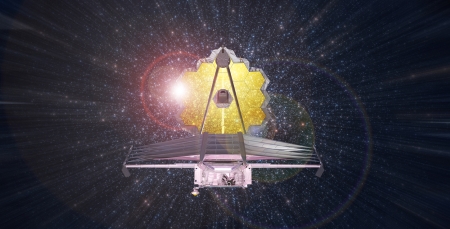Eureka on Europa! Once again, we turn our thoughts toward outer space and another Eureka moment supplied by the James Webb telescope. To put it briefly we have recently discovered that the James Webb telescope has verified carbon in a sub-surface ocean on the moon called Europa.
A Little Backstory on a New Discovery: Eureka on Europa

Eureka on Europa! The James Webb Telescope Discovers Carbon On One of Jupiter’s moons… The Essence of Life.
We have known for some time that our solar system might contain “conditions suitable for life.” Additionally, we have suspected that a suitable habitat for life could exist on Europa. If you recall your basic science, you know Europa is a moon of Jupiter. Thus, let’s note a few points about Jupiter before discussing Webb’s latest find on Europa.
1. You might know Jupiter is the fifth planet away from our sun. If you pictured it in your mind’s eye you might see its misty stripes and vast swirls, as shown in many photos.
2. “Jupiter’s stripes and swirls are actually cold, windy clouds of ammonia and water, floating in an atmosphere of hydrogen and helium.”
3. Jupiter is plain huge, more massive than all the other planets of our solar system combined.
Eureka: The Big Red Dot
Until now, the most exciting detail on Jupiter is the Great Red Spot. It is actually a fascinating storm. Scientists state it has been raging continuously for centuries.
However, the mysteries of that amazing visual will have to remain for another blog, another day. This blog is focused on the finding of carbon on the surface of the big Jupiter Moon, Europa.
Eureka for Europa: Basic Facts

Chalk Up Another Amazing Discovery in the Infinite Space Voyage of the James Webb Telescope.
With our title on this blog, you might wonder about the details of finding carbon on Europa. Exactly what has been found by the eyes of the amazing James Webb telescope? Keep reading to get all the details.
However, first, let’s detail a few amazing facts about Europa so you get a perspective on this moon-world. First of all, be aware that scientists have been considering Europa might be one of the places in our solar system that could “potentially harbor conditions suitable for life.”
What We Knew Before the James Webb Report
They know from previous work that there is a water-ice crust encasing the moon. Beneath that layer is a huge saltwater ocean. And furthermore, the seafloor is a rocky substrate of silicates.
A Few Facts About the Moon World Europa
Basic Fact 1: If you review grade-school science, you remember Europa is one of the largest of Jupiter’s more than ninety moons. It’s the sixth-closest moon to the planet. Europa and Jupiter’s three other largest moons – Io, Ganymede, and Callisto – were the first moons discovered beyond our own moon, from Earth.
Basic Fact 2: Scientists call these three, “the Galilean moons after Italian astronomer Galileo Galilei, who first observed them with a homemade telescope in January 1610.”
Carbon is the Secret of Eureka on Europa
Up until last month, scientists had no confirmation that the watery world actually contained the basic “chemicals needed for life, particularly carbon.” Then, astronomers checked data from NASA’s James Webb Space Telescope in search of carbon.
Indeed, the giant deep space telescope found it. The telescope found “carbon dioxide in a specific region on the icy surface of Europa.”
More validation occurred when the analysis also showed, “that this carbon likely originated in the subsurface ocean and was not delivered by meteorites or other external sources.” They also discovered that the carbon was a recent deposit, geologically speaking.
Why is this Eureka on Europa Important?

Electronic Chips Empower the Vehicles and Tools That Brings Our Minds Greater Understanding of Our Solar System.
In case you did not realize it, the existence of life as we know it is carbon-based. All of Earth loves a diversity of carbon-based life. To put it simply, the Webb telescope’s finding of an area of carbon dioxide implies the potential habitability of the ocean on Europa. Habitability for life as we know it truly provides a Eureka on Europa moment.
Now, using the James Webb Space Telescope, astronomers have found carbon on Europa’s surface, which originated in this ocean. The discovery signals a potentially habitable environment for life in the ocean of Europa.
(If we were normally reticent scientists, we would add, Boom, and a Mic-drop,” for this moment. It is more impressive than you might imagine.)
Eureka on Europa: Amazing NASA Findings
Geronimo Villanueva of NASA’s Goddard Space Flight Center in Greenbelt, Maryland, made announcements of the findings. He is the lead author of one of two independent papers describing the finding in the Eureka on Europa moment. He explained, “On Earth, life likes chemical diversity – the more diversity, the better.”
And he added, “Understanding the chemistry of Europa’s ocean will help us determine whether it’s hostile to life as we know it, or if it might be a good place for life.” He concluded, “We now think that we have observational evidence that the carbon we see on Europa’s surface came from the ocean. That’s not a trivial thing.”
Future Plans for Europa
In case you hear the fascinating area of Europa mentioned in the future, let us tell now that scientists have named it Tara Regio. “a geologically young area of resurfaced terrain known as “chaos terrain.” Within this area, astronomical pressures and storms break up the ice and allow the ocean to mingle with the crust.
Now that NASA has made its amazing Eureka on Europa moment, what happens after the discovery of Carbon? Up next on NASA’s plans is a probe, that will fly close to the moon-world and further study whether it presents conditions for life.
That will be a year from now, in October of 2024, and you can count on ER Precision Optics to bring you the report. NASA has named the probe the Europa Clipper. It is certainly a fitting name, with its connotations of choppy seas, wispy flags, and flying billows of sails.
A Lifetime of Knowledge in a Few Minutes: Eureka on Europa
Heidi Hammel of the Association of Universities for Research in Astronomy stated that it only cost the James Webb Telescope a few minutes of time for this amazing Eureka on Europa moment.
She said, “Even with this short period of time, we were able to do really big science. This work gives a first hint of all the amazing solar system science we’ll be able to do with Webb.”
The ER Optics Connection

Carbon, the Object of the James Webb Telescope’s Recent Discovery, Is a “Key Element of Life as We Know It.” Additionally, We Now Know It’s On Europa.
As you might guess, ER Optics is obsessed with the findings of outer space, especially with the discoveries of the James Webb telescope. It is a masterpiece of technology, utilizing much of the same technology and manufacturing as we create every day.
Without companies like ours, which specialize in growing Silicon and Germanium crystals, there could be no microchips. Additionally, without the crystal, there would be no way to empower outer space exploration instruments and vehicles.
Likewise, you would not have a smartphone, an electric car, or a blossoming Chips industry. Knowing that our work reaches from the phone in our pocket into the starry expanse of space inspires us daily to new goals in growth and product output.
Thank you for reading the ER Precision Optics blog and please, visit us again. We also invite you to check out our products page for a view of the wide range of work we offer.


